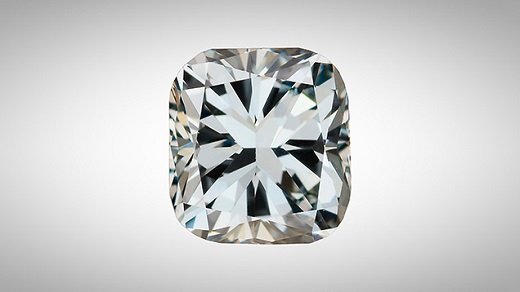GIA Spots Natural-Synthetic Hybrid Diamond
 RAPAPORT... The Gemological Institute of America (GIA) has discovered asynthetic layer that improved the weight and color of a natural diamond, and haswarned that the phenomenon may be happening more often. The cushion modified brilliant, 0.64-carat stone containedabout 0.10 carats of chemical vapor deposition (CVD) diamond, the GIA estimatedin a lab note last week. The lab-grown layer was greyish-blue, in contrast tothe natural section's yellowish color, giving the combined stone a fancy-greyish-greenish-blueappearance. This was not the first time a stone of this type has turnedup at the GIA: In 2017, it reported on a 0.33-carat, fancy-blue diamond thatfeatured a CVD overgrowth similar to this one. "With the second of these composites seen at GIA, this couldbe a new type of product entering the market," research associate Troy Ardon andanalytics technician Garrett McElhenny wrote in the note, which the GIApublished in the Spring 2019 issue of its quarterly scientific journal, Gems& Gemology. "The resulting color was likely the main motivation forgrowing the CVD layer on top of the natural diamond, though the extra weightgained could also be a factor." The stone's unusual nature came to light after testing indicatedit had features of both type Ia and type IIb diamonds - a rare combination. Itappeared to have absorbed both nitrogen - a feature of type Ia diamonds thatgives yellow color - and boron, which is present in type IIb stones and canturn them blue. "Mixed-type diamonds always call for additional scrutiny,"Ardon and McElhenny explained. The pavilion - the section from the girdle to the bottom - showednatural growth features during fluorescence testing with DiamondView, a DeBeers machine for identifying synthetics. However, the crown displayedcharacteristics of CVD, proving that manufacturers had grown CVD diamond over anatural base. Using computer modeling, the research team was able to calculate theweight of the synthetic part as approximately one-tenth of a carat. The stone was well disguised: Numerous readings of itsphotoluminescence showed no indication of any synthetic origin, despite thefact that such tests are usually effective at revealing CVD. This may bebecause the lab-grown layer was so thin, the note pointed out. "Natural diamonds with synthetic diamond grown on thesurface require extra scrutiny due to the presence of natural-looking features,both spectroscopic and gemological," the authors continued. "Careful inspectionstill reveals the presence of synthetic indicators, which expose the truenature of the diamond." Image: The natural diamond with a CVD overgrowth. (Robison McMurtry/GIA)
RAPAPORT... The Gemological Institute of America (GIA) has discovered asynthetic layer that improved the weight and color of a natural diamond, and haswarned that the phenomenon may be happening more often. The cushion modified brilliant, 0.64-carat stone containedabout 0.10 carats of chemical vapor deposition (CVD) diamond, the GIA estimatedin a lab note last week. The lab-grown layer was greyish-blue, in contrast tothe natural section's yellowish color, giving the combined stone a fancy-greyish-greenish-blueappearance. This was not the first time a stone of this type has turnedup at the GIA: In 2017, it reported on a 0.33-carat, fancy-blue diamond thatfeatured a CVD overgrowth similar to this one. "With the second of these composites seen at GIA, this couldbe a new type of product entering the market," research associate Troy Ardon andanalytics technician Garrett McElhenny wrote in the note, which the GIApublished in the Spring 2019 issue of its quarterly scientific journal, Gems& Gemology. "The resulting color was likely the main motivation forgrowing the CVD layer on top of the natural diamond, though the extra weightgained could also be a factor." The stone's unusual nature came to light after testing indicatedit had features of both type Ia and type IIb diamonds - a rare combination. Itappeared to have absorbed both nitrogen - a feature of type Ia diamonds thatgives yellow color - and boron, which is present in type IIb stones and canturn them blue. "Mixed-type diamonds always call for additional scrutiny,"Ardon and McElhenny explained. The pavilion - the section from the girdle to the bottom - showednatural growth features during fluorescence testing with DiamondView, a DeBeers machine for identifying synthetics. However, the crown displayedcharacteristics of CVD, proving that manufacturers had grown CVD diamond over anatural base. Using computer modeling, the research team was able to calculate theweight of the synthetic part as approximately one-tenth of a carat. The stone was well disguised: Numerous readings of itsphotoluminescence showed no indication of any synthetic origin, despite thefact that such tests are usually effective at revealing CVD. This may bebecause the lab-grown layer was so thin, the note pointed out. "Natural diamonds with synthetic diamond grown on thesurface require extra scrutiny due to the presence of natural-looking features,both spectroscopic and gemological," the authors continued. "Careful inspectionstill reveals the presence of synthetic indicators, which expose the truenature of the diamond." Image: The natural diamond with a CVD overgrowth. (Robison McMurtry/GIA)